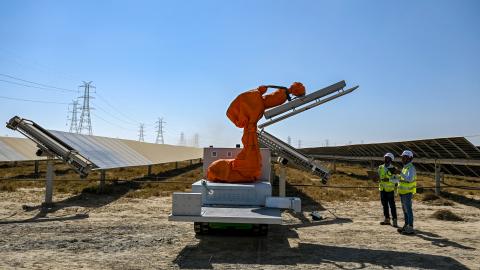India is the world’s fastest-growing emerging economy and is expected to become the third-largest by 2030. Key to India’s geopolitical aspirations and domestic economic ambitions is the enhancement of its manufacturing sector. Historically, the Indian State has chosen the path of indigenisation to bolster its civilian and defence industrial base. That approach, however, has yet to deliver concrete results.
In 2014, the flagship ‘Make in India’ initiative was launched by Prime Minister Narendra Modi. Its aim was to raise the contribution of manufacturing to India’s GDP from around 14 per cent to 25 per cent, with the additional goal of creating 100 million industrial jobs and boosting exports.
Unfortunately, as government data shows, the share of the manufacturing sector in India’s GDP remains the same in 2023-24 as it was in 2013-14—at 17.3 per cent. Furthermore, India’s exports as a share of GDP have not increased; instead, they have fallen from 25.2 per cent in 2013-14 to 22.7 per cent in 2023-24. The objective of creating millions of industrial jobs has also not been achieved, as evidenced by the rising unemployment rates, especially youth unemployment, raising important questions about the quality of jobs being created.
Additionally, the contribution of manufacturing to overall employment has declined, while the share of the agricultural sector has increased. This indicates a “reversal of structural transformation“ from a higher productivity sector to a lower one.
All of this should raise alarm bells at every level of the Indian government. A country of 1.4 billion with over 600 million in its labour force will be unable to provide jobs solely through services or agriculture. If India wants to continue its track record of pulling people out of poverty, it needs to rethink its policies for the manufacturing sector.
Reliance on PLI schemes
India’s current approach to boosting manufacturing relies heavily on identifying specific industries and providing government support to select firms through Production Linked Incentive (PLI) schemes. While PLIs can encourage both foreign and domestic companies to invest in India, they are not a substitute for a stable, predictable business environment.
PLIs may offer short-term benefits, but they are unlikely to significantly enhance the long-term global competitiveness of Indian firms. Moreover, the selection of the 14 sectors for incentivisation appears arbitrary, ranging from potentially sensitive industries like drones and electronic systems to others such as textiles and apparel.
Any firm entering a foreign market seeks policy predictability. Unfortunately, regulatory policy in India has often been marked by ad hocism. For instance, the lack of precision in India’s tax code and frequent changes in tax policies hinder corporate investments. Although the retroactive taxation rule may no longer hang like a sword of Damocles, foreign companies have yet to recover from its impact. Despite some attempts at course correction, India’s regulatory policy lacks transparency and efficiency in permitting and clearance processes.
India has long hoped to take advantage of geopolitical realities, where American and allied firms are hedging their bets and looking for markets other than China. While India is a sought-after market, it has witnessed a 43 per cent decline in FDI flow, while its ‘China Plus One’ competitor, Vietnam, saw a 32 per cent increase. This is because firms prefer countries that offer stable regulatory policies
Furthermore, poor coordination between government bodies often leads to conflicting regulations and inconsistencies, making it difficult for private players. For instance, reports suggest that while the Ministry of Electronics and Information Technology and the Ministry of Commerce and Industry sought easier visa norms for Chinese technicians, the Ministry of External Affairs and the Ministry of Home Affairs opposed it, causing delays in the installation of Chinese-made machines and impacting production in Indian factories.
Protectionism
Countries that seek to bolster any sector typically make it easier for firms to operate by incentivising their entry and ensuring they stay. The Indian State, however, remains protectionist at its core, and this is reflected in the challenges faced by its manufacturing sector.
India imposes high import duties and tariffs on raw materials, capital equipment, and intermediate goods. A recent study found that not only does India have high tariff rates, but these rates have been increasing since 2014. If we compare India’s tariff rate of 18 per cent, it is almost double that of Vietnam at 9.6 per cent and China at 7.5 per cent.
In addition to protectionist measures, restrictive labour regulations reduce manufacturing output, hurt employment, and lower productivity, often leading to fewer large firms. Instead of establishing large-scale firms with more labour, there is a tendency to either set up small firms or go for capital- and tech-intensive firms with less labour.
India’s historically restrictive labour laws create these challenges. In 2020, the Union government attempted to streamline labour regulations by consolidating 29 of its 44 laws into four new labour codes, but implementing these reforms has proven problematic. To avoid political and electoral headwinds, most state governments have refrained from touching them. The few that attempted reforms faced setbacks due to public backlash. For example, Tamil Nadu had to retract proposed working hour reforms after protests from trade unions.
If India is to become an alternative to China or a ‘China Plus One’ economy, it will need to reconsider its current approach to building its manufacturing sector, which has remained stagnant over the last decade. The US can serve as an ideal partner in India’s quest to become a global manufacturing hub.
In the next and concluding article, we will explore how the US-India economic partnership can help achieve this goal.
Enjoyed this article? Subscribe to Hudson’s newsletters to stay up to date with our latest content.

















